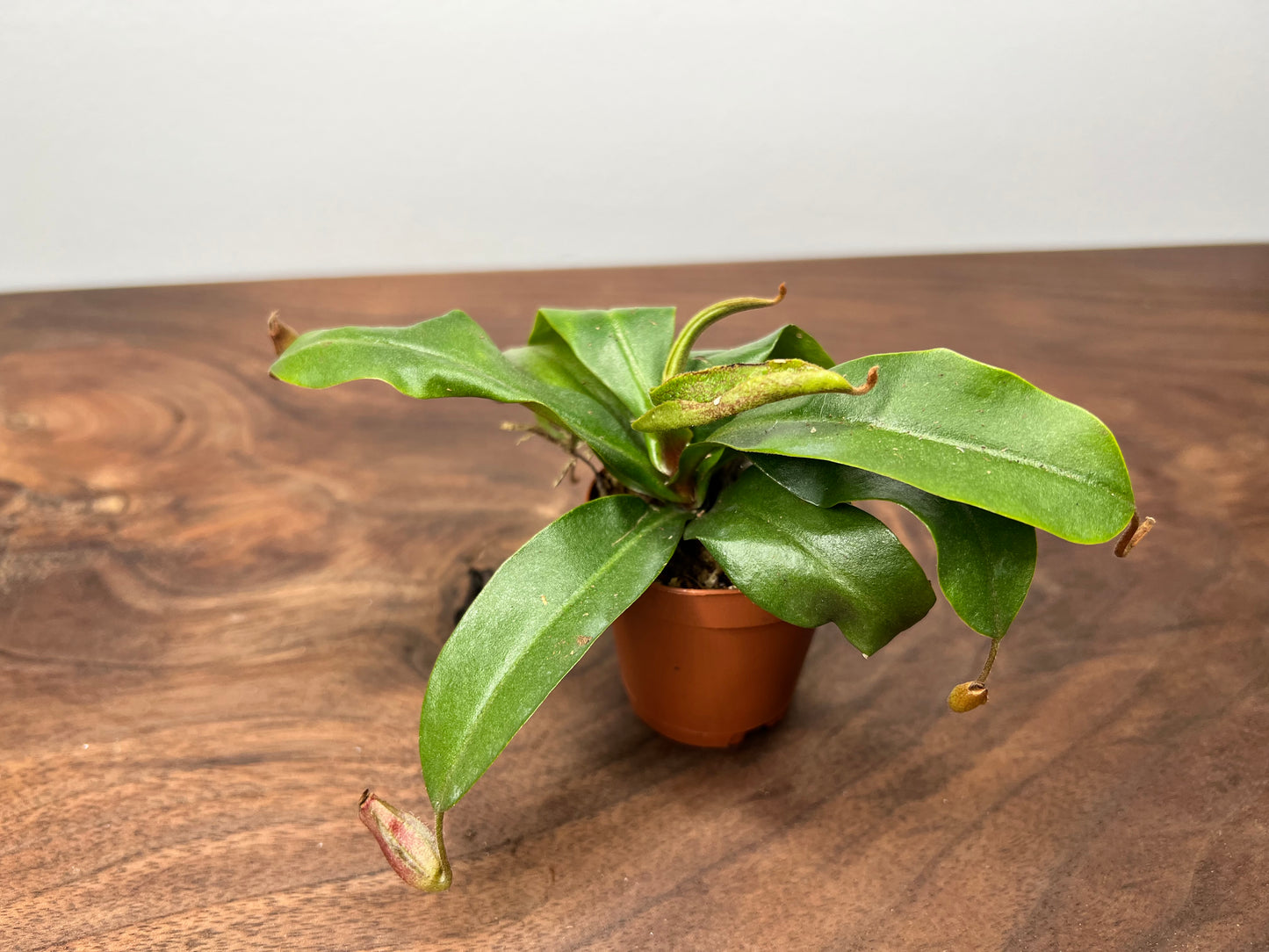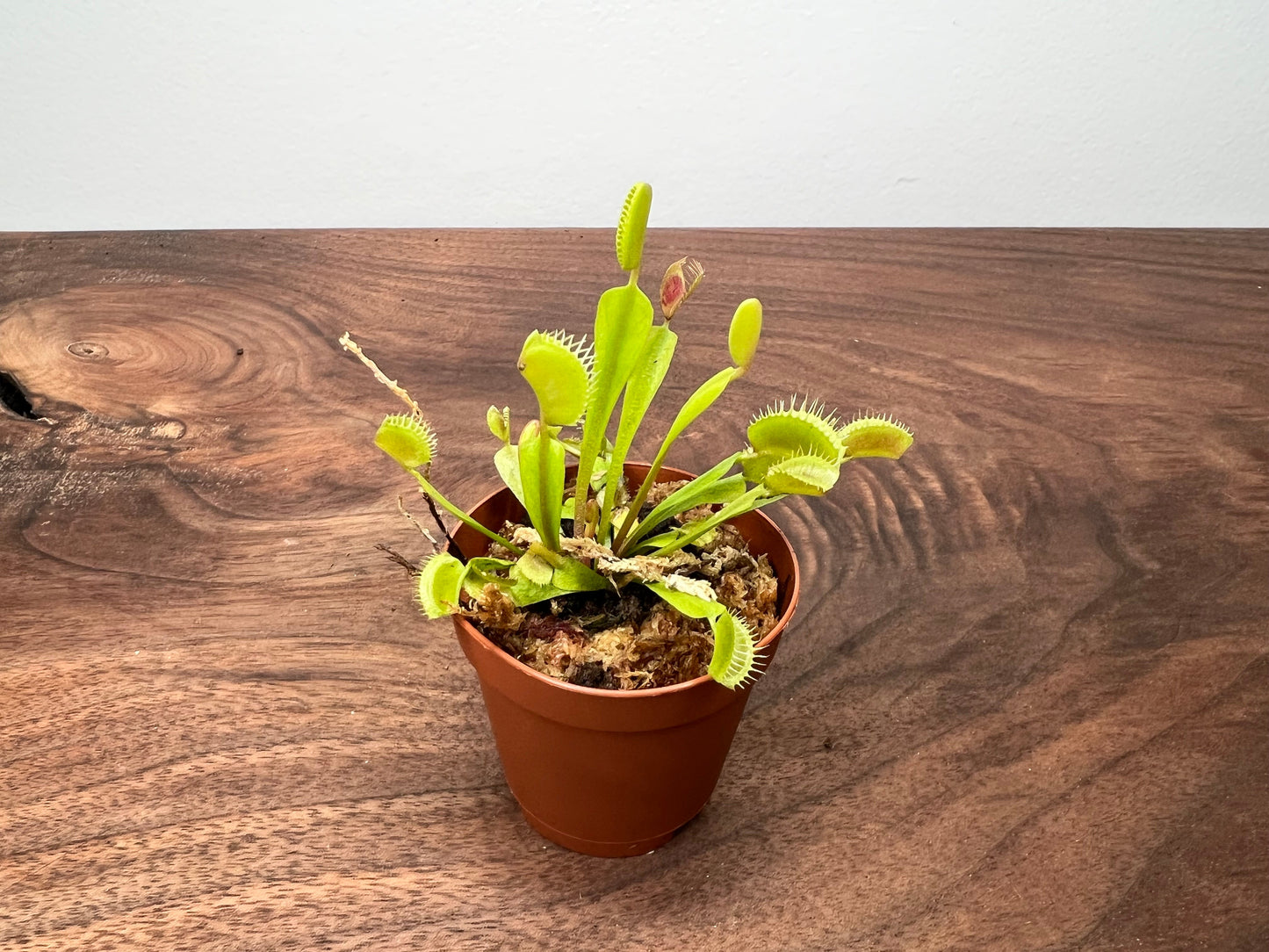The Rooted Plant Shop
Carnivorous Plant Starter pack #1 (3 plants)
Carnivorous Plant Starter pack #1 (3 plants)
Couldn't load pickup availability
Nepenthes, also known as tropical pitcher plants, is a genus of carnivorous plants native to Southeast Asia, Madagascar, and Australia. These plants are famous for their unique, pitcher-shaped leaves, which are specialized to trap and digest prey. The leaves grow into tubular structures that fill with a digestive liquid, attracting insects with sweet-smelling nectar. Once an insect lands on the slippery rim of the pitcher, it falls into the liquid below, where it is slowly broken down by digestive enzymes. Nepenthes are typically found in tropical and subtropical regions, thriving in nutrient-poor soils, where they supplement their diet with insects to acquire essential nutrients like nitrogen and phosphorus.
To care for Nepenthes, it is essential to recreate the warm, humid environment of their native habitats. They require bright, indirect sunlight, and while they do well in temperatures ranging from 70°F to 95°F. They cannot tolerate frost or extreme cold. These plants should be grown in a well-draining mix, typically consisting of sphagnum moss, perlite, and orchid bark, to mimic the acidic, low-nutrient soils they prefer. Nepenthes are sensitive to minerals in tap water, so distilled or rainwater should be used for watering. Humidity levels need to be high, around 50% to 60%, and they should be kept moist at all times. Though they can catch their own food, occasional feeding can be beneficial, especially when grown indoors where insects may be scarce.
One interesting aspect of Nepenthes is the incredible diversity within the genus. There are over 170 species of Nepenthes, with many subspecies and varieties that exhibit a wide range of forms, colors, and sizes. Some species, like Nepenthes rajah, produce large, robust pitchers that can trap prey as large as rodents, while others, like Nepenthes micramphora, are smaller and specialized in capturing tiny insects. Nepenthes pitchers vary in shape, with some being narrow and tubular, while others are more bulbous and squat. The coloration of the pitchers can range from bright greens to deep reds, with intricate patterns that attract different types of prey. The variety in pitcher shapes and trapping mechanisms is adapted to different environmental conditions, from the lowland species that thrive at lower elevations, to the montane species that live in higher, cooler climates.
One of the most popular varieties of Nepenthes for cultivation is Nepenthes x ventrata, a hybrid that combines traits from multiple species and is known for being easier to grow than pure species. Nepenthes alata is another common variety, prized for its attractive appearance and large, open pitchers. Nepenthes veitchii, with its striped or spotted pitchers, is also highly sought after for its stunning visual appeal. Some species, such as Nepenthes clipeata and Nepenthes lowii, are rare and endangered in the wild due to habitat destruction and over-collection. These species are often the focus of conservation efforts, as well as being a draw for dedicated carnivorous plant enthusiasts. The extraordinary diversity within the Nepenthes genus, along with their stunning, insect-catching ability, makes them a fascinating subject for both gardeners and botanists alike.
The Cape sundew (Drosera capensis) is a striking carnivorous plant native to the Cape of Good Hope in South Africa. Known for its long, slender, sticky, tentacle-like leaves, it captures prey with the help of glandular hairs that exude a glistening, sticky secretion. Insects and small invertebrates are lured by the dewdrops, which resemble drops of water, and when they land on the leaves, they become trapped. The plant then slowly curls its leaves around the prey, digesting it over time to absorb essential nutrients that are lacking in its native, nutrient-poor soil.
To keep a Cape sundew healthy, it is crucial to simulate the conditions of its natural environment. These plants prefer bright, indirect sunlight and can tolerate a variety of temperatures, but they thrive best in warm, humid conditions. It is important to keep the soil moist and use a well-draining mix, typically sphagnum moss, to avoid root rot. Like the Venus flytrap, Cape sundews are sensitive to chemicals and minerals found in tap water, so they should only be watered with distilled or rainwater. They also benefit from occasional feeding, though they can survive without it, as they can catch their own food when kept in optimal conditions.
One aspect of Cape sundews that many people don’t know is that they are highly adaptable and resilient. Unlike some other carnivorous plants, they can thrive in a wide range of conditions, making them an ideal choice for both beginners and seasoned plant enthusiasts. Their leaves are covered in glandular hairs, which secrete a sticky, mucilaginous substance that not only traps prey but also contains enzymes that help break down the trapped insects. This process provides the plant with vital nutrients like nitrogen and phosphorus.
Interestingly, the Cape sundew is also known for its ability to regenerate. If a leaf or part of the plant is damaged, it can often grow back, which adds to its appeal for collectors. Despite their ability to catch and digest insects, Cape sundews do not rely solely on prey for survival, and they can live on sunlight and water alone for extended periods. The species is widespread and relatively common in cultivation, but in the wild, it still faces some challenges due to habitat loss and climate change, highlighting the need for conservation efforts.
Venus flytraps (Dionaea muscipula) are fascinating carnivorous plants native to the subtropical wetlands of North and South Carolina in the United States. They thrive in nutrient-poor soil, where they have evolved to catch and digest insects to supplement their diet. These plants are typically small, with rosette-shaped leaves that have "jaws" that snap shut when tiny trigger hairs on the lobes are brushed twice. They are one of the few plants in the world capable of active movement, which is an extraordinary trait that makes them so captivating to botanists and enthusiasts alike.
To keep a Venus flytrap healthy, it’s important to replicate the conditions of its natural habitat. They prefer bright, indirect sunlight and should be grown in a spot where they receive at least 4-6 hours of sunlight daily. The soil must be very low in nutrients, so it’s best to plant them in a mix of sphagnum peat moss and perlite or sand. Venus flytraps also need high humidity and warm temperatures, typically between 70-95°F. Watering should be done with purified water, such as distilled or rainwater, since they are sensitive to the minerals in tap water.
Many people are unaware that Venus flytraps are not overly dependent on catching insects for survival. While they do catch prey, they can live on just sunlight and water for extended periods. They are adapted to catch insects mainly to supplement nutrients like nitrogen, which is scarce in their native soil. Additionally, each trap can only snap a few times before it becomes ineffective. Once a trap has caught its prey and "digested" it, it typically won’t function again, and the plant will rely on other traps to catch more food.
Interestingly, Venus flytraps have a relatively short lifespan in the wild, usually living 3-4 years, but with proper care, they can live much longer in cultivation. Some plants have been known to live up to 20 years in optimal conditions. In the wild, these plants face threats from habitat destruction, invasive species, and overcollection, which makes their conservation important. Despite these challenges, Venus flytraps are a beloved and popular subject for plant enthusiasts, offering a unique glimpse into the complex, insect-catching world of carnivorous plants.
Share
Join Our Loyalty Program
Join our loyalty program, and get rewarded for buying what you love.




Let customers speak for us
from 102 reviewsMel is an awesome plant parent. Her plants are well taken care of and healthy. She has a wide variety to choose from. I will be ordering more of my wish list plants from her in the future.

My plant arrived secured in peanuts, cling wrap at the base, a heat pack in the box also!!! It was cold here in Ohio. It is the perfect bonsai and exact one in the picture. I love it, I’m so happy.

Mel sent the most beautiful Alocasia I have ever seen! Packaged so well and very healthy! Highly recommend!

I ordered the subscription box and was able to pick which plant I wanted for the dollar value of my subscription. Mel helped me find a good plant to help with my air quality in my main living space. She was knowledgeable about the plants’ care and when it arrived the plant did NOT disappoint! It arrived just as gorgeous as it was when I picked it. She shipped it out on Monday and it arrived today, Tuesday. The shipping was crazy fast! The plants were very well packaged with fragile labels on almost every side. There was dirt kicked around in the box, but not as much as I would expect when shipping a pot full of soil. I definitely will recommend 1000 times again! Oh! Also she ships with heat packs! My new babies didn’t have to suffer the cold! ☺️
Had some typical USPS shipping issues and my peperomia arrived missing a few leaves... Mel is amazing and has kept up with me ever since to make sure it recovered! Plant arrived like it was preparing to go to war and has been thriving ever since. Will definitely be ordering again!!
I am super happy with my order and will only buy plants from The Rooted Plant Shop!! My plants are stunning!
The rooted plant shop has been more than amazing! This is my second purchase through the rooted plant shop. Couldn’t be any happier. My first purchase was a boobie cactus and my second is a Verigated Frydek. They included complimentary heat packs so the plant baby’s stayed warm! I would recommend this shop for any needs! The owner is very helpful with questions also!
Love this plant. Shipping was great and plant arrived in perfect condition.

This plant is gorgeous and is beyond what I was expecting. I will keep buying plants here because every one has arrived in perfect shape and packaged with care.

I Ordered three plants and have them delivered. They came in impeccable condition. They’re beautiful and the delivery was so fast highly recommend!!!!











